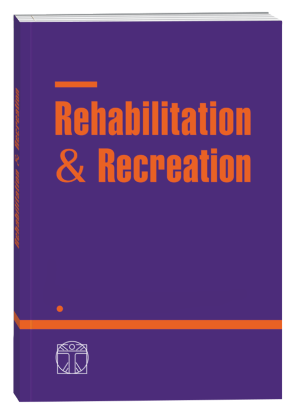HYDROCINESOTHERAPY AS A COMPONENT OF PHYSICAL THERAPY IN PERSONS WITH MUSCULAR DYSTROPHY
DOI:
https://doi.org/10.32782/2522-1795.2022.12.5Keywords:
hydrokinesitherapy, Duchenne muscular dystrophy, children, water exercisesAbstract
Duchenne muscular dystrophy (DMD) is the most common of a heterogeneous group of clinical, genetic, and biochemical disorders that share muscular clinical and dystrophic features. Despite the fact that global trends in the treatment of DMD are used in Ukraine, we were unable to find studies on the use of hydrokinesitherapy (HKT) in this pathology. We also conducted a search for publications in the databases of scientific and methodical literature that paid attention to the use of hydrokinesiotherapy for children with Duchenne muscular dystrophy over the past 10 years, using such keywords as hydrokinesiotherapy, water exercises, physical therapy in water, aquatherapy. The purpose of the study is to identify the availability of scientific literature on the use of hydrokinesitherapy as a component of physical therapy in persons with muscular dystrophy. Studying this literature, we found that the application of HKT went in such main directions as: comparison of motor function on land and in water; evaluation of the clinical effectiveness of HKT; determining whether HKT is effective from the point of view of functional mobility; examination of the effect of HKT on the speed and energy expenditure during locomotion while sitting on a flat surface and functional access in persons with DMD; description of the evolution of the end of immersion time in patients with DMD; assessment of respiratory changes and functional outcomes in DMD patients. Conclusions: the number of publications studying the issue of hydrokinesitherapy in DMD has not significantly increased over the past five years, but it is quite limited. We agree with previous researchers that there is no consensus on which exercises should be used in DMD, but an important condition is that the patient should not be fatigued. In the future, it is necessary to analyze the peculiarities of hydrokinesotherapy methods for DMD and their effectiveness.
References
Марчук МС. Світові тенденції терапії м’язової дистрофії Дюшена [Інтернет] Український медичний часопис, 2019, 27 лютого [Цитовано 2022 серпень 22]. Доступно: https://www.umj.com.ua
Adams S, Hutton S, Janszen A, Rawson R, Sisk C, Stenger S, et al. Effects of an Individualized Aquatic Therapy Program on Respiratory Muscle Function in Adolescents with Muscular Dystrophy. Arc Phys Med Rehab 2016;97:E130-1. https://doi.org/10.1016/j.apmr.2016.08.407
Atamturk H, Atamturk A. Therapeutic effects of aquatic exercises on a boy with Duchenne muscular dystrophy. J Exerc Rehabil. 2018 Oct 31;14(5):877-882. doi: 10.12965/jer.1836408.204. PMID: 30443536; PMCID: PMC6222151.
de Lima AAR, Cordeiro L. Aquatic physical therapy inindividuals with muscular dystrophy: Systematic scoping review. Fisioter Pesqui. 2020;27:100-11 https://www.scielo.br/j/fp/a/nKyjnPfr5d49yNt45Cs7pWS/?format=pdf &lang=en
Ferreira AVS, Goya PSA, Ferrari R, Durán M, Franzini RV, Caromano FA, et al. Comparison of motor function in patients with Duchenne muscular dystrophy in physical therapy in and out of water: 2-year follow-up. Acta Fisiátrica. 2015;22, 51–4. DOI: 10.5935/0104-7795.20150011
Gamper U, Waller B. Método de los anillos de bad ragaz. In: Rodríguez JG, Fraile MA, de las Peñas CF, ed. lit. Terapia acuática: Abordajes desde la fisioterapia y la terapia ocupacional. Elsevier. 2015, p. 243-265
Garcia MK, Joares EC, Silva MA, Bissolotti RR, Oliveira S, Battistella LR. The Halliwick Concept, inclusion and participation through aquatic functional activities. Acta Fisiatr. 2012;19(3):142-150 DOI: 10.5935/0104-7795.20120022
Hind D, Parkin J, Whitworth V, Rex S, Young T, Hampson L,et al. Aquatic therapy for childrenwith Duchenne muscular dystrophy: a pilot feasibility randomised controlled trial andmixed-methods process evaluation. Health Technol Assess. 2017;21(27): DOI: 10.3310/hta21270
Honório S, Batista M, Martins J. The influence of hydrotherapy on obesity prevention in individuals with Duchenne Muscular Dystrophy. J Phys Educ Sport. 2013;13, 140–146 doi: 10.21506/j.ponte.2016.8.25
Huguet-Rodríguez M, Arias-Buría JL, Huguet-Rodríguez B, Blanco-Barrero R, Braña-Sirgo D, Güeita-Rodríguez J. Impact of Aquatic Exercise on Respiratory Outcomes and Functional Activities in Children with Neuromuscular Disorders: Findings from an Open-Label and Prospective Preliminary Pilot Study. Brain Sci. 2020;10(7). DOI: 10.3390/brainsci10070458
Hydrotherapy for Duchenne muscular dystrophy (DMD): a pilot and feasibility randomised controlled trial in children. Hydrotherapy for DMD Research Protocol. Version: 6,18 Nov 2015. 27 р.
Nicolini RD, Braga D, Pires CVG, Oliveira RAF. Efeitos da Imersão nos Parâmetros Ventilatórios de Indivíduos com Distrofia Muscular de Duchenne. Rev Neurocienc 2012;20:34-41.
Ogonowska-Slodownik A, de Lima AAR, Cordeiro L, Morgulec-Adamowicz N, Alonso-Fraile M, Güeita-Rodríguez J. Aquatic Therapy for Persons with Neuromuscular Diseases – A Scoping Review. J Neuromuscul Dis. 2022;9(2):237-256. doi: 10.3233/JND-210749.
Santos CPA, Hengles RC, Cyrillo FN, Rocco FM, Braga DM. Aquatic physical therapy in the treatment of a child with merosindeficient congenital muscular dystrophy: Case report. Acta Fisiatr. 2016;23, 102–6 DOI: 10.5935/0104-7795.20160020
Silva KM, Braga DM, Hengles RC, Beas ARV, Rocco FM. The impact of aquatic therapy on the agility of a nonambulatory patient with Duchenne muscular dystrophy. Acta Fisiatr. 2012;19, 42–5. DOI: 10.5935/0104-7795.20120009
Voos MC, Albuquerque-Goya PS, Leal de-Freitas B, Teixeira-Pires AM, Meire-Favero F, Aparecida-Caromano F. Timed immersion expiration measures in patients with muscular dystrophies. Arch. Physiother. 2020;10:4. doi: 10.1186/s40945-020-0074-3.
Winter D, Nocetti PM. Aqatic physiotherapevtic interventions in Dushennemuscular dystrophy: review article. Revista Fisioterapia & Reabilitação, 2017;1(2):19-26
Downloads
Published
How to Cite
Issue
Section
License

This work is licensed under a Creative Commons Attribution-NonCommercial-NoDerivatives 4.0 International License.











